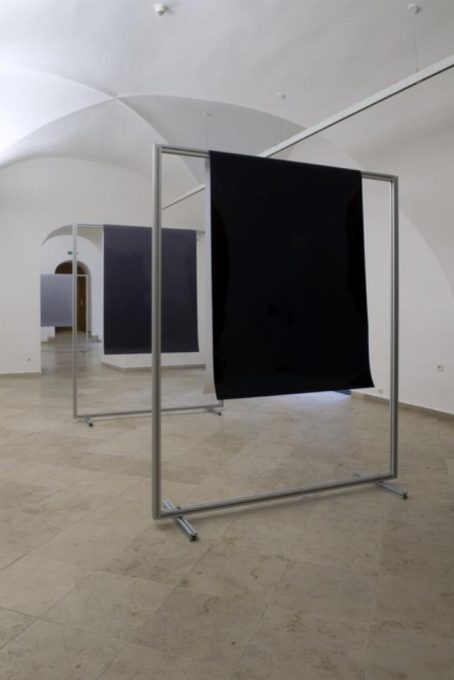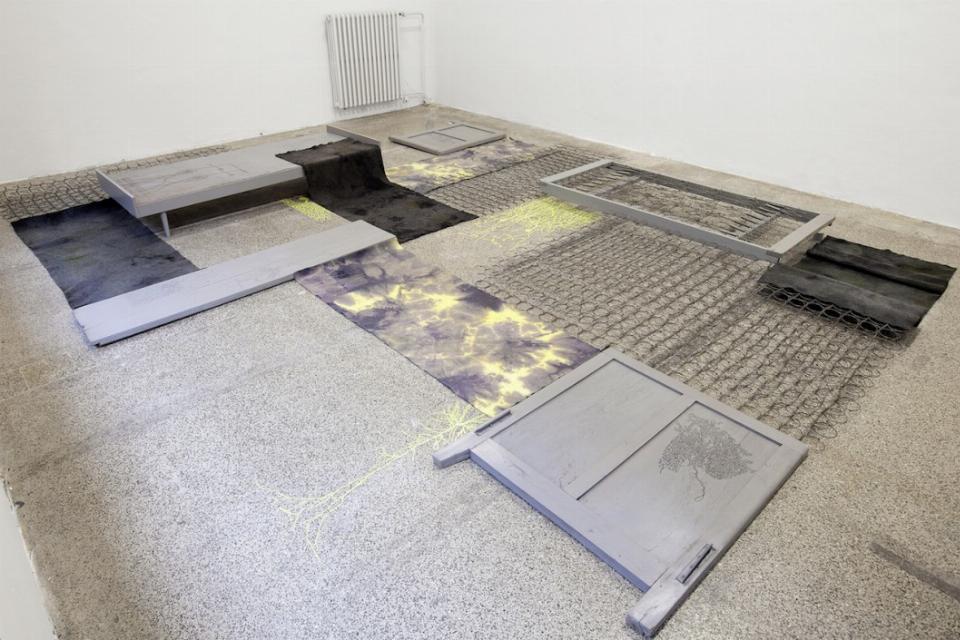Inner Image. Appearing / disappearing Images
The aim of the Inner Image. Appearing / disappearing images exhibition is to present the complex structure of artistic reflection which is often concerned with issues of truth in the artwork and its relation to the real world. In their work, artists draw a boundary between the image of reality and its internal reflection.
The nature of contemporary artwork reveals artists’ ability to respond to latest technologies. They are, in a sense, a medium of humanization, or making the world of people ‘human’. If we try to generalize and present in an artwork a formal truth which finds its way to the surface, into the space of the image, then we confine our attention to the shape that has been immortalized in the truth – and to the truth immortalized in the shape.*
Some works displayed at the show may appear simple, and yet they hide elaborate content based on philosophical reflection, social and political relations, scientific concepts or, sometimes, pure intuition. But they all refer to the ‘inner truth’ of the work which stems from the impulse to take a critical look at reality.
Western culture and philosophy pushes disappearance, void and nothingness into the background as phenomena related to passing, eradication or concealment. Still, representing nothingness is meaningful.
In Jaromír Novotný’s work the properties of material, the transparency of light and the surface of picture are brought about by numerous fairly simple interactions. Aleš Čermák’s magic images – especially the AISandSIA video – display themes of both sophisticated state-of-the-art technology and primitivism which evidence the softness and brutality of religious and political institutions or totalitarian regimes as instruments that erase human traces. In Echo, a series of acoustic drawings by Daniel Hanzlík, the artist’s gesture, guided by a mental sound signal, becomes an instrument harmonizing the inner rhythms of the sound and the author’s thoughts. His almost mechanical precision brings a machine to mind. In the Light Sleep project, the artistic duo Julia Gryboś and Barbora Zentková investigate sleep as a state of apparent inactivity. Yet we know very well that many actions and changes happen during sleep. Milan Houser uses fluorescent varnish which produce effects of darkness and light. As a result, his works show a new reality and gain a different dimension. Jan Lesák explores the limits of the medium of photography. In his project called Running in Haze, he suggests unclear and blurred boundaries between reality and representation. Svätopluk Mikyta is a distinguished figure on the Czechoslovak art scene. In his prints, he refers to the ideological communist past, as well as to history in general, or to local traditions and memory. Josef Mladějovski examines the basic problem of modernism: ideas of utopian meanings and gestures. Their significance is critically revaluated in his work. Pavel Mrkus’s video installation addresses the question of media which appropriate privacy – after all, the drone is a surveillance device. The principle behind the work consists in relaxing the form by radical repetition of fast changing image frequency. Gregor Eldarb’s work is an extension of spectacular urban visions, turned by the artist into unforgettable structural models. Libor Novotný’s object Wooden Web signals a characteristic feature of the artist’s reflections. For him, the work tends to be a semantic code, whose processual and ephemeral nature makes it changeable in accordance with physical phenomena, targeted at the viewer’s attention.
We would like to foreground the critical and social role of art, communicated in a universal language. The participating artists employ a wide range of techniques and methods of creative work: installations, painting, drawing and video.
František Kowolowski
translated from Polish by Monika Ujma
* M. Heidegger, ‘The Origin of the Work of Art’, [in:] M. Heidegger, Basic Writings, New York: HarperCollins, 2008.
Inner Image
Appearing / disappearing images
‘Internal reflection, minimal exposure between two concepts.’
Western philosophy and culture are chiefly preoccupied with the concept of discovery, while the question of disappearance tends to be disregarded: aesthetics, epistemology, religious or technical experience rely on the premise that something will emerge/appear that can be sensed, imagined and conceptualized. In this ontological preference the emphasis is on arising and realizing, while the process of decomposition, decay, destruction or destabilization of forms and relations is neglected. Still, disappearance is of utmost importance despite its inferior place in Western thought. Religious and political institutions as well as logic have tried their hardest to destroy and nullify everything contrary or problematic, not to mention totalitarian regimes which obliterate human traces. This is most conspicuous in high-tech societies, accountable for dramatic disappearance (of bodies, realities, forms, etc.), virtualization and dematerialization.
At the notional level, discovery and disappearance can be revealed through art. Disappearance may be linked to passing, destruction, removing from view or repositioning. Identity of a concealed picture (virtual world) is defined by destruction and the speed at which each forms here disappears. This is emptiness which is not nothingness but virtuality; it embraces all possible forms that can be uncovered so that they can instantly vanish without consequence. Nothing causes more disquiet than Something. An idea which disappears is, to a large degree, shaped by forgetting.
It is therefore practically impossible to analyze these two processes separately. They permeate each other and pose the question of place and time: where/when something disappears and where/when something appears?
‘…painting perceives itself as a model (pure view) and keeps returning to itself by obsessively repeating the code. Let us remember that behind simulation of reality there is always the reality of painting which will never surpass its own shadow.’
‘And so art is everywhere, since artifice is at the very heart of reality. And so art is dead, not only because its critical transcendence is gone, but because reality itself, entirely impregnated by an aesthetic which is inseparable from its own structure, has been confused with its own image. Reality no longer has the time to take on the appearance of reality. It no longer even surpasses fiction: it captures every dream even before it takes on the appearance of a dream. Schizophrenic vertigo of these serial signs, for which no counterfeit, no sublimation is possible, immanent in their repetition-who could say what the reality is that these signs simulate? They no longer even repress anything (which is why, if you will, simulation pushes us close to the sphere of psychosis). Even the primary processes are abolished in them. The cool universe of digitality has absorbed the world of metaphor and metonymy. The principle of simulation wins out over the reality principle just as over the principle of pleasure.’*
* J. Baudrillard, excerpt from Simulations, 1983, http://www.english.txstate.edu/cohen_p/postmodern/theory/baudrillard.html.
Cooperation from the gallery: Magdalena Godlewska-Siwerska
Aleš Čermák, Gregor Eldarb, Julia Gryboś/Barbora Zentková, Daniel Hanzlík, Milan Houser, Jan Lesák, Svatopluk Mikyta, Josef Mladějovský, Pavel Mrkus, Jaromír Novotný, Libor Novotný

PLAN YOUR VISIT
Opening times:
Thuesday – Sunday
10:00-18:00
Last admission
to exhibition is at:
17.30












